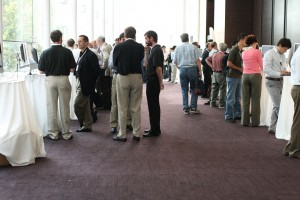I was invited to speak at one of our executive client briefings last week. The theme of the “Executive Perspective” was examining the “Core/Edge Dynamic.” nGenera defines the “core” as the collection of processes, systems and infrastructures that have evolved over many years and effectively run today’s large enterprise. The “edge” is the emerging suite of Internet-based capabilities that promise a huge competitive advantage in the form of increased innovation, productivity and agility. My role, specifically, was to demonstrate how an “Edgling*” leverages social networking and web applications for personal productivity and innovative gains for the enterprise.

Part of the agenda included a talk by Gregory Berns, the Distinguished Chair of Neuroeconomics at Emory University. Berns’ soon to be published book, “Iconoclast” outlines how and why iconoclasts essentially think and behave differently than non-iconoclasts. In 2.0 evangelism, very similar to the role of an iconoclast, we’re attempting to change people’s behavior which Berns admits is difficult and uncomfortable. As a part of the lecture, we were given advance copies of Berns’ book. I was particularly drawn to his chapter on “Brain Circuits for Social Networking.” This chapter explains that in order for an iconoclast to be successful and sell a new idea, he or she must leverage two variables key to social intelligence: reputation and familiarity.
In my talk, although I was chartered to expose our clients to a “new way of web-working,” I found I was not connecting with the audience. For starters, as this was the first time I was before this particular set of clients, they had no idea who I was or what level of authority or credibility I had to present my ideas. Although my nGenera colleagues did a great job of introducing me and how I work, the clients had no firsthand experience with me, so they therefore (especially given the content of my presentation) met my ideas with skepticism. So I failed on the first variable, reputation, to sway my audience to consider a new way of working.
Secondly, the matter of familiarity delivered the final death knell to my chances of converting any new prospects to my scary 2.0 religion. For the most part, what we (edglings) immerse ourselves in daily on the social web is wholly alien to the way large enterprise management works. Many of our clients are not even in front of a computer most of the day. It’s a series of back-to-back management meetings and various engagements where they’re reviewing or preparing presentations in order to make decisions on operational issues that keep the company gears running. The suggestion to stay tethered to a micro-blogging platform was received as eagerly as if I had asked them to grow antennas out of their heads.
Of course, there is always the unfortunate possibility that I was just an awful presenter and that is the reason why the session did not go over well. (We did have a little Skype trouble…) Yet, I know how to read an audience, and it was obvious to me they just weren’t connecting with what I was trying to show and explain to them. In Berns’ book, he explains that in order for an iconoclast to effectively sell a new idea he or she must make the audience comfortable with the idea. In fact, there is neurological evidence that suggests the brain processes unfamiliar things as “alarming and potentially dangerous.”
I’m publishing this account of my experience to caution other evangelists to explore as many ways as possible to bridge the gap between what the client already knows and the richness of what you are trying to present. Our eagerness to spread the “good news” of 2.0 will continue to fall on deaf ears if we can’t make the story relevant and compelling in terms the clients can appreciate. Further, we need to summon our own courage to overcome their innate biological fear of change in order to truly unleash radical innovation.
*”Edgling” was originally coined by Stowe Boyd.









